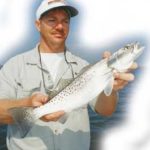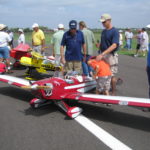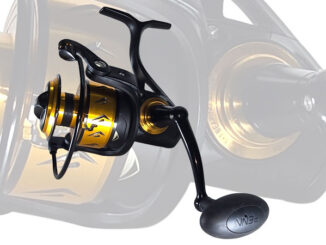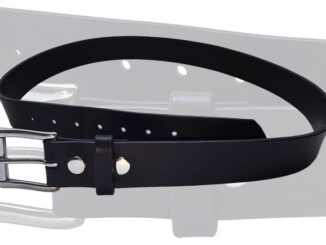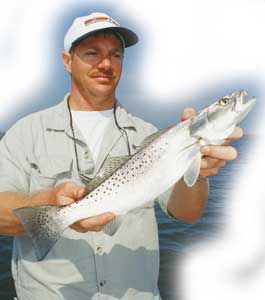
Effort is down and catches are up across most of Louisiana’s coast
Hurricanes Katrina and Rita put trout fishing on hold across much of the state, but once anglers were able to get back on the water, success harkened back to days of yore when limits came fast and furious and competition from other anglers was almost nil. “I had many, many trips where I limited out on reds and trout in two hours,” Ron Price of Fishing Intimidator Guide Service said. “I had some trips where I limited out on striped bass as well, and didn’t have to pull the anchor.
“You cast in one direction and catch a trout. You cast in another direction and catch a red. You cast in another direction and catch a bass.”
Price concentrated his efforts in the Mississippi River from the Jump in Venice to Buras, and said every cut he stopped held fish.
“You couldn’t go anywhere without catching fish,” he said. “Fish were bunched up.”
Similar reports of incredible fishing came out of Delacroix, Big Lake and other waters slammed by the two monster storms, but Price said he wonders if all the quick creels accurately reflected the health of the trout population following the storm.
“You’re talking about a lot of fish in the river system, but it’s hard to say that the fish all survived,” Price said of his stomping grounds. “How many fish actually died in the storm? I don’t think we’re going to know until after the spring.
“I don’t think we’re hurting, but I don’t think it made it better.”
That’s the million-dollar question Louisiana Sportsman posed to Department of Wildlife & Fisheries biologist Harry Blanchet, who is responsible for keeping up with the health of marine fisheries within the state.
Predictably, Blanchet was reticent to make a hard-and-fast prediction on what the year holds for trout fishermen, but he said the hurricanes really shouldn’t have had much impact.
“To the best of our ability to determine, the storms really did not affect the trout populations,” he said. “The primary thing the storms did was, along with the lack of rain fall between then (September) and December, it really increased salinities.”
However, patterns could have been changed drastically.
“They’re not in their usual haunts,” Blanchet said. “You had a lot of sediments filling up the winter holes.
“What was a 15-foot-deep spot might be a mud flat now.”
Price said he found just that situation fishing the waters out of Buras in February.
“I ran to a canal that usually holds fish during the winter,” he said. “The areas where it was shallow before I had to run through mud and spots of marsh grass.
“When I got back to the where the deep water used to be, it was shallow. A 7-foot canal was now 2 ½ feet deep. That spot is completely ruined.”
That means anglers will have to relearn their favorite areas.
“It’s going to develop whole new patterns,” Price said. “That’s tough on guides because you spend years learning honey holes, and it’s like starting all over again.”
But what does this really mean when it comes to predicting fishing success this year? Well, nothing — outside the fact that it might take anglers some time to find where trout congregate in the post-Katrina-and-Rita world.
What Blanchet and his ilk look at are scientific data, much of which is independent of recreational fishing.
Some of the news from those samplings doesn’t bode incredibly well for the fishery, although the news isn’t all bad.
For instance, seine samples conducted by biologists indicate there are fewer fish in the water to be caught.
“Over the last several years (since 2001), on a statewide basis, the catch efforts in seines have been lower than what we normally see,” Blanchet said.
That’s bad news.
Harvest surveys by DWF researchers, however, indicated that recreational anglers boated an estimated 8.1 million trout in 2004, the last year for which final data are available.
“Except for the year 2000, that was the highest in recent history,” Blanchet said. “My general perception was that last year wasn’t much bigger than the average, but we don’t have the final numbers on that.”
That’s good news.
Another mixed blessing comes in Blanchet’s expectations that fishing pressure will drop this year.
“Even now, we’re seeing reduced efforts, particularly in those areas that were hardest hit,” he said. “You’ve got a lot of people working on their houses. Some may not have boats. Others may be waiting for landing facilities to come back.
“New Orleans accounts for a large portion of the recreational harvest, and they may have other things on their minds.”
The one area of the coast that has not really been impacted in terms of fishing pressure is that central portion comprised of western Lafourche and Terrebonne parishes.
“There’s really been no change in that part of the state,” Blanchet said.
In fact, there could be a slight overall increase because of anglers moving from the devastated areas to that stretch of marsh.
“People who normally fish Venice might move west and fish that Terrebonne marsh,” he said.
That issue aside, Blanchet said the high harvest rates in 2004 provide a good snapshot of what could be expected this year, and it’s more good news.
“It was relatively small fish,” he said of the trout making up most of that year’s harvest. “If you’ve got those high harvest rates with small fish, there are two ways it can be: Either people fishing on small fish, or there are a lot of small fish to be had.”
If the latter was the case, Blanchet said that could point to better sizes this year.
“With one more year of growth, you should have more big fish,” he said.
That assessment is backed up by 2005 gill-net samples, which mirrored the seine-sample results since 2001-02.
“Gill-net information has also been a little below average since 2001 and 2002,” Blanchet said. “However, in ‘05 we saw a rebound in the smallest two meshes. There was a higher catch effort (in those sizes) than what we had seen in ’02, ’03 and ’04”
The trout caught in those two smaller mesh sizes account for the higher number of small fish in 2004 and 2005, but that should translate to more larger fish this year as those trout move to the next age class.
Of course, there can be huge numbers of fish in the water during one year’s sample, but they have to survive the unpredictable winter conditions to remain available for harvest.
That was proven in 1989, when a major cold blast killed millions of trout.
Fortunately, Blanchet said winter survival shouldn’t be a major issue this year.
“We had a very mild winter,” he said. “It wasn’t until mid January that we started seeing temperatures come down to seasonal levels.
“Fishing typical of November was going on at Christmas time.”
The warm weather has meant trout were more active, and the presence of more bait allowed those fish to gorge themselves.
“When you think about winter in an estuary, one of the primary factors you have to think about is food availability,” Blanchet said. “This year, we had such mild conditions that we had more food available.”
The reasons such piles of shrimp, anchovies, silversides, menhaden, cocahoes and storm minnows remained in the estuaries during the winter are somewhat ambiguous.
“I don’t know if it was the storms, the continued high salinities or the water temperatures, or a combination thereof,” Blanchet said.
One thing he does know: The combination of warm temperatures and plenty of food could mean good things as the year’s fishing unfolds.
“Having all of these things — food sources, mild temperatures, etc. — will probably increase survivability,” Blanchet said.
Even assuming high survival rates this year, there are other factors involved in catch rates, however.
One is the amount of fresh water flowing into the systems.
For those marshes from Vermilion Bay to the Mississippi Sound, that depends largely on what happens far to the north.
“A wet, cold spring (up north) can make for a high river down here, and that water’s still cold when it gets down here,” Blanchet said.
If enough of that cold water moves into the estuaries of coastal Louisiana, anglers also might have to wait a bit longer for the sows to move in to spawn.
“They may not start (spawning) until May because of compressed temperatures,” Blanchet said.
High stages on the Atchafalaya and Mississippi rivers also tend to muddy up marshes within their influence, and, even worse, reduce salinities in prime spawning areas.
“They move to areas that have adequate salinities for spawning,” he said.
Freshened marshes will mean that trout have to move farther and farther out of the inner estuaries to find suitable salinities to allow successful spawning.
However, Blanchet warned that finding muddy river water in a favorite trout hole doesn’t necessarily mean it’s ruined.
“Just because you’ve got muddy water on top doesn’t mean you’ve got muddy water on the bottom,” he said. “You may have stratification.
“You might have this murky, fresh river water over the top of some saltier, cleaner water.”
Of course, particularly shallow areas probably will be muddy from top to bottom.
As of late February, however, Blanchet really didn’t foresee a big problem with high rivers.
“Right now, there’s not much snow pack up there,” Blanchet explained. “But a lot can happen.”
If the rivers jump way up this spring, Blanchet said success simply requires some adjustment by anglers.
“With a high river, you might not have as much action in Venice,” he said. “You might have to move over to Grand Isle, the Timbaliers.”
OK, that’s plenty of background on the general overview of the state’s upcoming trout season, but what about your favorite area? Blanchet narrowed down his discussion to the state’s estuaries to help anglers know what to expect when they hit the water this year.
DWF sampling indicates there should be pretty good fishing in the fertile waters east of the Mississippi River, which includes the Lake Pontchartrain system.
“Looking at our samples, they were at or above our long-term averages in ’05, and 2004 was also strong in that area,” he said.
The big question in much of the area — Delacroix, Hopedale, the Rigolets — is habitat.
“That area was hit very hard by Katrina,” Blanchet said.
Again, that means anglers probably will have to figure out where trout will be in the system.
“There will be a learning curve,” he said.
Caution also was recommended.
“In that area, especially, people are going to have to be so careful about debris,” Blanchet said. “We’re talking about camps and boats, pilings, you name it. You’ve got those oil fields in Black Bay and other areas, and they’re still looking for pipelines. We’re not talking about bumping some light.
“Every time you go out, it’s a substantial risk.”
Access continues to be a concern in that area, with only backdowns available in much of the region, but those making it onto the water should find good numbers of fish.
The central portion of the coastline, stretching from Barataria Bay to the Atchafalaya River, is one of the low points in Blanchet’s forecast.
“They really did not have as strong a year as east of the river in 2005,” he said. “It was similar to ’04.”
That could mean decent numbers, but mostly small trout.
However, Blanchet quickly added a caveat.
“The results could show some variability in sampling. It could be salinity or (trout) distribution,” he said. “We don’t sample everywhere, and it’s such a big system.”
Habitat is a serious issue in this stretch of the state, but that is more of a concern looking down the road than in the near term.
“We’re seeing a lot of that marsh really come apart, and what that means in terms of long-term productivity of those marshes is still too early to tell,” Blanchet said.
But it’s inevitable that the system will fall on hard times without major restoration efforts.
“Eventually, we’re not going to have the populations we have right now,” Blanchet said. “It’s got nothing to do with fishing. It’s got to do with you need to have habitat.
“It’s the same reason (duck conservation groups) have been getting rights to support wetlands in Canada for decades: You’ve got to have the habitat.”
The real danger isn’t spawning, since fish are going to find areas to spawn. Instead, marsh loss really impacts survivability when trout are most vulnerable.
“Those little juveniles need to have those little, sheltered ponds,” Blanchet said. “Those little sheltered ponds are becoming big, open bays.
“Some of those Terrebonne marshes have gone to heck in a handbasket.”
The irony is that this probably accounts for strong catches in recent years.
“In the short term, it makes for great speckled trout fishing,” Blanchet said. “But you’ve got to have those ponds that increase survivability among juveniles. They’re going to have a better food source, and they’re going to be protected from those big predators in those sheltered ponds.”
Moving a bit westward, Blanchet said the waters just to the west of the Atchafalaya River are always difficult to pinpoint.
“The Vermilion Bay area gets so influenced by the Atchafalaya River,” he said. “You’ve got to talk about it by itself.”
Sampling this winter revealed good supplies of shrimp and baitfish, but how the system lays out in the coming months really depends on what happens in points far north of coastal Louisiana.
“If we have a low spring river, you could have a decent April run, but if we have a high spring river, all bets are off,” Blanchet said.
Southwest Louisiana has been having great fishing, and it could actually benefit from the effects of Hurricane Rita.
“That hurricane popped open an awful lot of those levees around that lake, so you have a lot more productivity,” he said. “It had essentially become a bowl with a pipe through it, and now you end up getting more exchange with the marshes.
“You have the potential over the next few years to have a lot more productivity in that lake.”
That’s great news for a system that’s become known for trophy trout.
But Blanchet said researchers still are trying to pinpoint exactly why the system produces such hefty stringers.
“It’s always been a bit of a question where those (huge) trout come from,” he said “It’s always been my opinion that a lot of these fish are actually staying on the coast, and move in when the salinities (in the lake) get high enough.
“Essentially, that’s new recruitment to those areas, and some stay and some move out when the salinities fall.”
In fact, Blanchet said his agency finds plenty of huge trout wintering in the system.
“Some of our largest samples taken in that area are in the wintertime,” he said. “Both in terms of numbers and size.”
The reason is fairly elementary.
“Big Lake does not have the Atchafalaya River,” he said. “They’ve got higher salinities in Big Lake.”
That means that, barring heavy localized rains, the lake’s salt content remains high enough to support trout year round. Of course, that can change quickly.
“If you have the lake turn fresh, there go your fish,” Blanchet explained.
What all of this means is that trout populations overall are in good shape.
“I’d say there’s nowhere in the state where you don’t have a good chance to catch fish,” Blanchet said. “I expect harvest rates to be similar to last year, given an average river, given an average spring.”
Overall harvest might be a slightly different story.
“If I had to make a prediction on overall harvest, I would say it would probably be below last year’s because of reduced effort,” Blanchet said.
Again, that’s a mixed blessing.
“Reduced effort means increased survival,” he said. “Looking out past this year to next year, there’s at least the potential of seeing, not necessarily more fish, but larger fish.”
